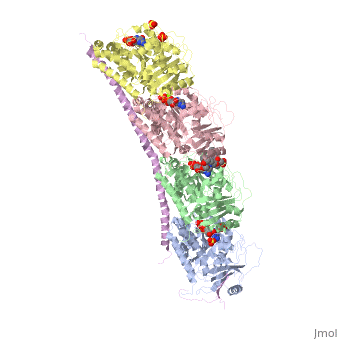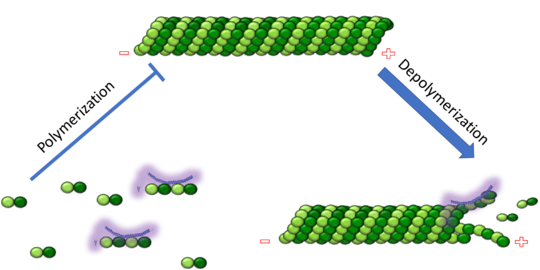User:Alisa Cario
From Proteopedia
(Difference between revisions)
| (7 intermediate revisions not shown.) | |||
| Line 14: | Line 14: | ||
[[4eb6]] | [[4eb6]] | ||
| - | <StructureSection load='4eb6' size='400' side='right' caption='Structure of stathmin bound to two tubulin heterodimers at 3.47Å resolution. | + | <StructureSection load='4eb6' size='400' side='right' caption='Structure of stathmin bound to two tubulin heterodimers at 3.47Å resolution solved through X-ray diffraction. |
| - | Tubulin dimers are stabilized by | + | Tubulin dimers are stabilized by vinblastine, shown by grey spheres between heterodimers. Stathmin protein is from ''Rattus norvegicus'' while tubulin is purified from ''Ovis aries'' brain. (PDB entry [[4eb6]])' scene=''> |
| Line 27: | Line 27: | ||
== '''Function''' == | == '''Function''' == | ||
| - | <scene name='77/778894/Stathmin/1'>Stathmin</scene>, also known as oncoprotein 18 or metablastin, is a 19kDa microtubule associated protein known to destabilize microtubules <ref>PMID:8598048</ref> | + | <scene name='77/778894/Stathmin/1'>Stathmin</scene>, also known as oncoprotein 18 or metablastin, is a 19kDa microtubule associated protein known to destabilize microtubules <ref>PMID:8598048</ref>. These proteins are cell cycle and developmentally regulated, known to play a role in proliferation, differentiation, and function of cells <ref>PMID:9312271</ref> <ref>PMID: 9880330</ref>. Stathmin family proteins can bind to <scene name='77/778894/Highlight_of_tubulin/1'>two tubulin dimers</scene> to inhibit polymerization or can bind to the microtubule to enhance the rate of catastrophe<ref>PMID:8598048</ref> The structure of stathmin-4, in 4eb6, is bound to two tubulin heterodimers. The tubulin dimers are bound to outside ligands. <scene name='77/778894/Vinblastine/1'>Vinblastine</scene> is a chemotherapeutic that binds to tubulin to prevent microtubule polymerization <ref>PMID: 1687171</ref>. The tubulin subunits are bound to <scene name='77/778894/Gtp_gdp_highlight_of_tubulin/1'>GTP/GDP.</scene> The beta subunits of tubulin are bound to GDP and each of the alpha subunits are bound to GTP and a Magnesium ion. |
[[Image:Stathmin_figure_cario1.png|center|thumb| upright=3| Figure 1. Adapted from ''Ruben 2004''. Stathmin, in purple, can bind to tubulin dimers to prevent polymerization or to microtubules to increase the rate of catastrophe. ]] | [[Image:Stathmin_figure_cario1.png|center|thumb| upright=3| Figure 1. Adapted from ''Ruben 2004''. Stathmin, in purple, can bind to tubulin dimers to prevent polymerization or to microtubules to increase the rate of catastrophe. ]] | ||
| Line 35: | Line 35: | ||
'''Migration''': The cytoskeleton is a vital part of cell migration. Microtubules are needed to retract from the trailing edge to move the cell forward. Stathmin is thought to have a role in migration, allowing to microtubules to depolymerize to aid in movement. Stathmin has been show to be a part of the integrin alpha5 beta1/FAK/ ERK pathway <ref>PMID: 9462839</ref>. Overexpression of stathmin increases motility of GN-11 neurons <ref>PMID:15625246</ref>. | '''Migration''': The cytoskeleton is a vital part of cell migration. Microtubules are needed to retract from the trailing edge to move the cell forward. Stathmin is thought to have a role in migration, allowing to microtubules to depolymerize to aid in movement. Stathmin has been show to be a part of the integrin alpha5 beta1/FAK/ ERK pathway <ref>PMID: 9462839</ref>. Overexpression of stathmin increases motility of GN-11 neurons <ref>PMID:15625246</ref>. | ||
| - | '''Differentiation''': Stathmin family proteins expression are regulated during stages of development. | + | '''Differentiation''': Stathmin family proteins expression are regulated during stages of development. They are regulated in early and late embryogenesis <ref>PMID: 1893566</ref>. Stathmin is regulated in differentiating muscle cells, T lymphocytes, and oligodendryocytes <ref>PMID: 22529300</ref> <ref>PMID: 14603467</ref>. |
| Line 42: | Line 42: | ||
<scene name='77/778894/Stathmin_alone/1'>Stathmin</scene> consistis of a coiled coil alpha helix in the C-terminal region and a mostly disordered N-terminal region that also has some beta strand properties. These different regions of the protein are known to have different functions. | <scene name='77/778894/Stathmin_alone/1'>Stathmin</scene> consistis of a coiled coil alpha helix in the C-terminal region and a mostly disordered N-terminal region that also has some beta strand properties. These different regions of the protein are known to have different functions. | ||
| - | + | [[Image:Stathmin_seq.png|center|thumb| upright=3| Figure 2. Stathmin structural domains related to amino acid sequence ]] | |
====How does the structure relate to it's function?==== | ====How does the structure relate to it's function?==== | ||
| Line 48: | Line 48: | ||
The <scene name='77/778894/Stathmin_nterm/1'>N-terminal region</scene> is known to increase tubulin catastrophe. This region helps destabilize the ends of the microtubule filaments by curving the tubulin dimers at the end, and disrupting lateral hydrogen bonds. The N-terminal region is known as the regulatory domain of the protein, because it is subject to most of the post-translational modifications. This region binds and caps alpha tubulin to accomplish this task <ref>PMID: 9880330</ref>. The neuronal family members are known to contain an additional N-terminal domain to affect their localization <ref>PMID: 9788875</ref> | The <scene name='77/778894/Stathmin_nterm/1'>N-terminal region</scene> is known to increase tubulin catastrophe. This region helps destabilize the ends of the microtubule filaments by curving the tubulin dimers at the end, and disrupting lateral hydrogen bonds. The N-terminal region is known as the regulatory domain of the protein, because it is subject to most of the post-translational modifications. This region binds and caps alpha tubulin to accomplish this task <ref>PMID: 9880330</ref>. The neuronal family members are known to contain an additional N-terminal domain to affect their localization <ref>PMID: 9788875</ref> | ||
| - | The<scene name='77/778894/Stathmin_c_term/1'> C-terminal region</scene>, also known as the interaction domain, is known to sequester tubulin heterodimers. This region is comprised of a <scene name='77/778894/Stathmin_coiled_coil/1'>coiled-coil alpha helix</scene>. This region of stathmin is <scene name='77/778894/Zoom_of_stathmin_on_alpha/1'>known to bind to helix 10 of alpha tubulin</scene>. Helix 10 of alpha tubulin is thought to be important for incorporation into microtubules <ref>PMID: 9880330</ref>. All members of this family contain the C-terminal coiled coil domain. However, the binding affinity to tubulin | + | The<scene name='77/778894/Stathmin_c_term/1'> C-terminal region</scene>, also known as the interaction domain, is known to sequester tubulin heterodimers. This region is comprised of a <scene name='77/778894/Stathmin_coiled_coil/1'>coiled-coil alpha helix</scene>. This region of stathmin is <scene name='77/778894/Zoom_of_stathmin_on_alpha/1'>known to bind to helix 10 of alpha tubulin</scene>. Helix 10 of alpha tubulin is thought to be important for incorporation into microtubules <ref>PMID: 9880330</ref>. All members of this protein family contain the C-terminal coiled coil domain. However, the binding affinity to tubulin differs from protein family members <ref>PMID: 11278715</ref> |
| + | |||
| + | There are <scene name='77/778894/Mutations_in_stathmin/1'>two mutations</scene> to stathmin-4 in this structure. The mutations at position 11 from an cysteine to an alanine and position 16 from a Phenylalanine to a Tryptophan. | ||
== '''Disease relevance''' == | == '''Disease relevance''' == | ||
| - | |||
| - | '''Multiple Schlerosis''': Stathmin expression is has been linked to multiple sclerosis (MS) , a neurodegenerative disorder characterized by lack of motor control and numbness. MS is caused by loss of myelination on axons in the nervous system. Myelination of axons is performed by cells called oligodendrocytes. Stathmin is regulated in oligodendrocyte lineage, with progenitor cells containing larger amounts than differentiated oligodendrocytes. Brain tissue samples from people suffering from multiple sclerosis found that stathmin is up regulated later in the lineage of oligodendrocytes. The up-regulation of stathmin showed a more globular morphology of the cells. Oligodendrocyte ability to myelinate axons in the central nervous system was greatly reduced in these patients <ref>PMID: 15659612</ref>. | ||
'''Cancer''': Due to stathmin's role in mitosis and cell migration, it is not surprising that is has been implicated in many cancers and is an active target of cancer therapeutics. Stathmin is defined as an oncoprotein. Overexpression of stathmin has been shown to increase metastasis, worse prognosis, and increased chemoresistance <ref>PMID: 20087351</ref> <ref>PMID: 18930345</ref>. Stathmin levels are known to be increasesd in a number of cancers. Stathmin was seen to be upregulated in breast cancer tissue comparative with normal breast tissue <ref>PMID: 10638981</ref>. Another study was done to show stathmin upregulation in esophageal squamous cell carcinomas <ref>PMID: 23229199></ref>. Studies using a non-phosphorylatable stathmin mutant shows that cells arrest during mitosis <ref>PMID: 9788875</ref>. | '''Cancer''': Due to stathmin's role in mitosis and cell migration, it is not surprising that is has been implicated in many cancers and is an active target of cancer therapeutics. Stathmin is defined as an oncoprotein. Overexpression of stathmin has been shown to increase metastasis, worse prognosis, and increased chemoresistance <ref>PMID: 20087351</ref> <ref>PMID: 18930345</ref>. Stathmin levels are known to be increasesd in a number of cancers. Stathmin was seen to be upregulated in breast cancer tissue comparative with normal breast tissue <ref>PMID: 10638981</ref>. Another study was done to show stathmin upregulation in esophageal squamous cell carcinomas <ref>PMID: 23229199></ref>. Studies using a non-phosphorylatable stathmin mutant shows that cells arrest during mitosis <ref>PMID: 9788875</ref>. | ||
| + | |||
| + | '''Multiple Schlerosis''': Stathmin expression has been linked to multiple sclerosis (MS) , a neurodegenerative disorder characterized by lack of motor control and numbness. MS is caused by loss of myelination on axons in the nervous system. Myelination of axons is performed by cells called oligodendrocytes. Stathmin is regulated in oligodendrocyte lineage, with progenitor cells containing larger amounts than differentiated oligodendrocytes. Brain tissue samples from people suffering from multiple sclerosis found that stathmin is up regulated later in the lineage of oligodendrocytes. The up-regulation of stathmin showed a more globular morphology of the cells. Oligodendrocyte ability to myelinate axons in the central nervous system was greatly reduced in these patients <ref>PMID: 15659612</ref>. | ||
== Links to available structures == | == Links to available structures == | ||
Current revision
* Full Real Name: Alisa Cario
- Position: Graduate Student
- Institution (NO ABBREVIATIONS): University of Vermont
- City, State/Province, Country: Burlington, VT USA
- Field of Expertise or Study: Creation of protopedia page for a class project. The class is Proteins 1 under Dr. Stephen Everse
Stathmin-4 (RB3) bound to Tubulin stabilized with Vinblastine
4eb6
| |||||||||||


